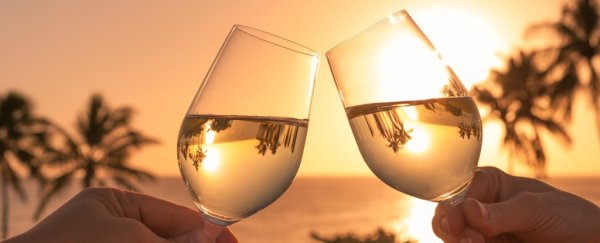The radioactive fallout of the Fukushima nuclear disaster in 2011 cast an irrevocable toll on the environment within Japan – and outside of it – and years later, the legacy of its toxic contamination is still being discovered.
Even the sun-kissed vineyards of California weren't immune to Fukushima's shadow, it seems, with scientists having now found heightened traces of radiation in wine vintages grown in the famous Napa Valley after the nuclear emergency.
To be clear, these heightened but faint traces of the radioactive isotope Caesium–137 don't pose a health risk to humans, experts say, so you probably don't need to drink less wine (well, at least not on that score). But it's still an amazing, stark reminder of how widely nuclear accidents can be felt.
In this case, French experimental physicist Michael Pravikoff from the Centre d'Études Nucléaires de Bordeaux-Gradignan happened upon a series of Californian wines (Cabernet Sauvignon) from vintage 2009 through to 2012 while shopping in a supermarket.
The spread of the vintages game him an idea. Caesium-137 isn't a naturally occurring isotope, and is only produced via nuclear fission; it's something scientists can look for in unopened wine bottles, using a technique involving gamma spectrometry (aka gamma spectroscopy).
In the past, researchers have used this method to show how the isotope's levels in wine spiked after the missile testing of the Cold War (and also after the Chernobyl accident) – a tell-tale signature that's primarily useful for identifying and dating vintages in cases of wine fraud.
In this instance, Pravikoff wondered whether Fukushima's radioactive outreach of Caesium-137 would have extended as far as the Californian vineyards a world away (or at least an ocean away) from the Japanese coastline – and was in fact, now bottled right in front of him.
"I just bought them, just to see," Pravikoff told The New York Times.
"It is more for the pure scientific aspect that we were interested in measuring them."
When he and fellow researchers used gamma spectrometry to try to detect Caesium-137, the faintness of the results was inconclusive, so they resorted to a more brute-force method: scorching the wine in an oven at temperatures up to 500°C (932°F) for several hours, which reduces the contents of a bottle to just a few grams of ash.
This technique showed the level of Caesium-137 in Cabernet Sauvignon wine effectively doubled from 'background' levels after Fukushima happened, and a similar spike was also evident in a sample of Californian rosé (although the levels were much lower than in the Cabernet Sauvignon).
For his part, Pravikoff says there's no need to be worried, as the results are genuinely only of scientific interest, given the faintness of the radioactive traces.
"These levels are so low, way below the natural radioactivity that's everywhere in the world," he told The New York Times.
That point is echoed in WHO's official FAQ on the risks of consuming food grown in other countries after Fukushima.
"Minute amounts of radioactive caesium and iodine might be found using very sensitive detection methods," the advisory states, "but this should not affect foods produced in other countries as the amounts involved will be well below acceptable levels and would not pose a health concern to those who eat the food."
So there's definitely no need to be alarmed.
But next time you're at a Californian wine tasting, you may wish to share an observation on those subtle but appreciable notes of Caesium-137 on your tastebuds, which really add something quite indefinable to the overall bouquet.
The findings are available at the pre-print website arXiv.org.
